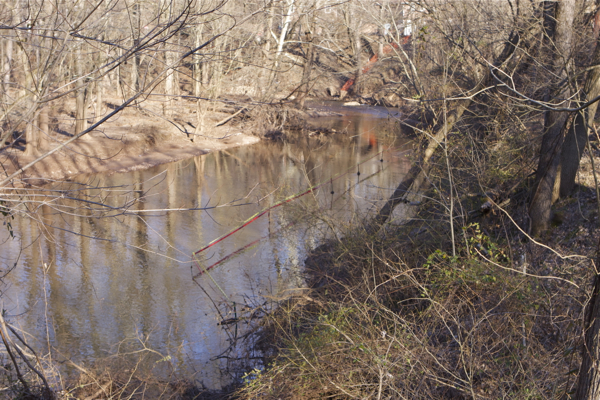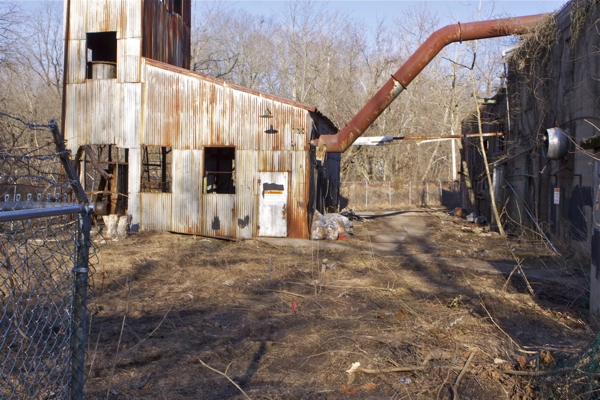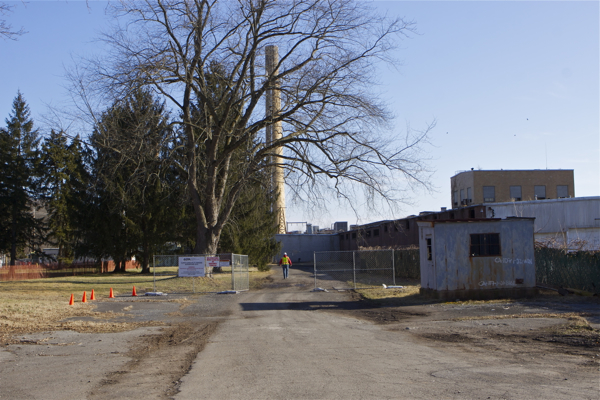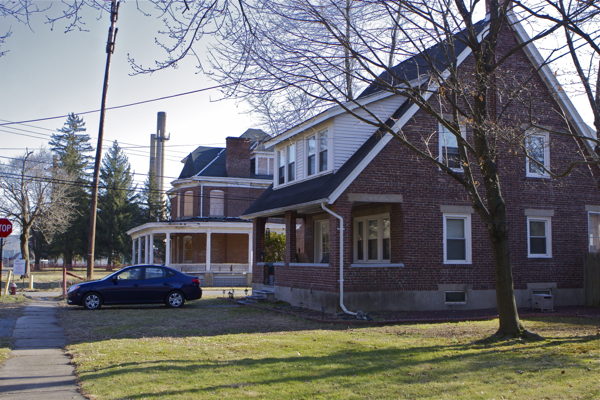
Bank collapses into stream. PCBs were found in areas along banks of Quequacommisacong Creek, in the sediment (sludge) of a discharge pipe from the facility and in the sediment downstream of the facility outfalls.
Premature to Expect Redevelopment When Full Cleanup Is Years Away
[Update: 2/3/12 below
It seems like whenever I go looking for trouble, I manage to find it.
Last summer, I testified at the public hearing on the Riegel Paper Superfund site up the Delaware River from me. I raised a series of concerns about EPA’s proposed final cleanup there, and issues with nearby Riegel paper sites (see: EPA Crown Vantage Landfill Superund Site Cleanup Plan Proposed
In followup, EPA promised – but failed – to email me the final EPA Record of Decision documents, response to my comments, and future public notices.
So, always suspicious when I get blown off by the bureaucracy, I decided yesterday to visit the related nearby Curtis Specialty Paper Superfund site and do some document reviews today.
Surprise surprise! It seems I just came across another cascading series of either errors or attempts to hide important information.
First of all, the EPA webpage for the Curtis Specialty Superfund site in Milford NJ does not include links to any remedial documents that would provide information regarding the pollution problems and risks at the site.
Second, the NPL Superfund listing public notice link that is provided on the EPA webpage is incorrect. So it is not easy to find the basis for the NPL listing. I had to Google to find it, and came across this sketchy NPL Site Narrative and rationale (which is not linked on the main EPA page for Curtis Specialty):
Need for NPL Listing:
The State of New Jersey referred the site to EPA. Other federal and state programs were evaluated but are not viable at this time. The State has written a letter of support for placing this site on the NPL.[The description of the site (release) is based on information available at the time the site was evaluated with the HRS. The description may change as additional information is gathered on the sources and extent of contamination. See 56 FR 5600, February 11, 1991, or subsequent FR notices.]
So, having no clue what a “subsequent Federal Register Notice” is, we moseyed on over to the February 11, 1991 Federal Register cited.
Here is what I am looking for:
The Headquarters Superfund docket contains:
- HRS scoresheets for each proposed site;
- a documentation record for each site describing the information used to compute the HRS score;
- information for any site affected by particular statutory requirements or EPA listing policies; and
- a list of documents referenced in the documentation record.
But we found none of that or anything specific about Curtis Specialty site or the EPA Superfund listing documents. We found EPA reference to a 1991 Fed Reg. notice odd, because the CS cite wasn’t abandoned until 2003.
Third, while we found nothing on pollution, we did find all the good news, including a September 23, 2009 press release announcing Superfund listing of the site, where EPA set the tone and shaped local expectations:
We have already addressed the most immediate threats at this site and secured it to prevent access and further deterioration, said Acting Regional Administrator George Pavlou. Now it is time to take a close look at what might be needed to protect the surrounding community into the future. By listing this site, we can move forward on a further investigation of additional threats that the site may pose over the long-term.
I really can’t comprehend how EPA could imply that the major problems are solved and allow local folks to form expectations that redevelopment is remotely on the horizon, when the facts of the site are troubling and the Superfund process takes years.
EPA doesn’t even have the RP’s legally on the hook for cleanup and the extent of cleanup is not clear (RI underway), but it could include costly and complex investigation of the groundwater and the Delaware River and off site sediment removal.
Superfund cleanup likely will have a significant impact on the feasibility of any future redevelopment.
So people need to focus on putting the public health horse (i.e. a permanent cleanup to residential standards that is protective of and compensates for damages to stream and river natural resources) before the redevelopment cart –
EPA did flag problems:
EPA’s future investigations will center on polychlorinated biphenyls (PCBs), the main contaminant of concern at the site. PCBs have been detected in soil at the site and along the banks of Quequacommisacong Creek. PCBs have also been found in pipes that discharge from the site to Quequacommisacong Creek and in the creek. PCBs are probable human carcinogens, which may also have serious effects on the immune, neurological and reproductive systems. The creek is a fishery, and feeds into the Delaware River, which is adjacent to the site. The Delaware River is a major fishery, and there are many sensitive environments, such as wetlands and habitats for endangered species in the vicinity.
Here’s what the Quequacommisacong Creek looks like today, about 200 feet from confluence with the designated Wild and Scenic Delaware River – there are posted warning signs and police tape, but no fences and it sure doesn’t look like any cleanup has occurred there:
[Update: I don’t want to create the misimpression that EPA screwed up this site.
DEP asked EPA to get involved and to list the site under Superfund.
Specialty Paper was required to cleanup the site under NJ State laws immediately after it shut down operations.
DEP failed to enforce NJ State cleanup laws at the site: (or file liens for cleanup costs):
In August 2001, Curtis Specialty Papers submitted a preliminary assessment report and remedial investigation work plan to the New Jersey Department of Environmental Protection (NJDEP) as part of the State’s Industrial Site Recovery Act. The company identified 20 areas of concern at the Curtis Specialty Papers, Inc. site. In July 2003, Curtis Specialty Papers shut down its operations and declared bankruptcy. The facility was abandoned and left unsecured. On October 20, 2006, NJDEP and their emergency response contractor began activities that included securing oil and hazardous materials containers, classifying materials for waste disposal, inspecting above ground storage tanks, collecting and stowing empty containers at the former hazardous materials storage area, and transporting and disposing of materials. Approximately two dozen drums and lab packs were removed from the facility.
Additionally, there could be problems related to a legal settlement with Crown Vantage– I am still trying to understand the ownership structure, it is possible that Crown purchased the liability of a subsidiary Specialty Paper, the RP at the site.
An EPA consultant’s Report traces the ownership history
2.3.2 Ownership
Site owners and operators have changed through time among several entities, including Riegel Paper Corporation, Federal Paper Board Company, Inc., Riegel Products Corporation, James River Corporation, James River Paper Company, Inc., Crown Vantage and Curtis Papers, Inc. (including their predecessors, subsidiaries and other related ventures).
Bingo!
A prior 2001 DEP settlement with Crown Vantage and $1 million settlement may explain DEP inaction at the Curtis Specialty Paper site.
Check this out – focus on highlighted text – “any and all property”. According to a recent Appellate Division decision:
Approximately six years after Crown purchased the landfill, it filed for bankruptcy protection in the Northern District of California. As part of those bankruptcy proceedings, it filed a motion under 11 U.S.C.A. § 554 to abandon its interest in this landfill, as well as several others that it owned and operated. The DEP objected to this abandonment because of the potential risks to the environment posed by abandoned landfills. To secure the DEP’s agreement to this motion, Crown agreed to pay $1 million to the DEP to be used “to investigate, close, clean-up, or otherwise remediate any environmental condition on any and all property” of Crown in New Jersey. Based upon this payment, the DEP withdrew its objection to the motion, and the bankruptcy court entered an order on March 2, 2001, authorizing the abandonment of this property. The order entered by the bankruptcy court simply referred to abandoning the property and did not mention the 1991 agreement that structured the manner in which the landfill was to operate, nor did it convey title to the underlying land.
Following entry of that order, the DEP used a majority of the funds from Crown to close up another of Crown’s landfills that it considered to require immediate attention. The DEP did no more with the Warren Glen landfill than to periodically visit it and to mow the grass to keep it from becoming overgrown.
So, what explains DEP failures and the EPA Superfund listing?
Were the DEP’s hands tied by a sweetheart $1 million bankruptcy settlement?
Did DEP try to cover their mistake by asking EPA for a Superfund cleanup?
Did EPA play right along with that game?
Are RP’s wiggling off the hook? – end update]

notice the police tape restricting access to the stream bank, which is washing out and collapsing into the stream!


EPA consultants reinforced these unrealistic expectations in a July 2010 Report:
Reuse Assessment Report (July 2010)
The Reuse Assessment provides information to develop a realistic understanding of reasonably anticipated future use of the site. It considers information related to land use and planning, such as property ownership, physical constraints, zoning and local ordinance, regulatory constraints, and community input. In the end, this Reuse Assessment presents an understanding of potential future use, which can be used to inform the Superfund process to ensure protection of human health and the environment.[…
The USEPA named IP and GP as responsible parties associated with the site, and on June 4, 2009, IP and GP entered into an AOC with the USEPA to perform an RI/FS at the site. [Note: RI/FS is study, not cleanup]. IP and GP subsequently purchased the site in June 2009. IP, GP, and USEPA amended the AOC on November 8, 2010 to include pre-demolition activities at the site. [ Note: again, this is not complete cleanup].
Take a look at the redevelopment potential there – hardly “shovel ready”:


Monday’s Hunterdon County Democrat story repeats these wildly unrealistic expectation of site redevelopment and reuse: Milford citizens group meets tonight too discuss Riegel Paper Mill site needs, nice cleanup ends
Organizer Rob Castagna and wife Linda own Chestnut Hill Bed and Breakfast and have some ideas they’d like to advance. “The big question we have is: What’s next? What happens when the property is all cleaned out and there’s nothing left?”
I don’t know what EPA or local officials and residents are thinking about, but does this site look like there is no “further deterioration” and that it is time for redevelopment planning?
The EPA consultants are preparing a RI/FS.
EPA does not have a binding commitment from the polluters to cleanup the site, but merely to study it.
So take a look at all the progress – and see what it looks like from the front yards of nearby residents:




Pingback: WolfeNotes.com » EPA to Hold Public Meeting On Crown Vantage and Curtis Paper Superfund Sites
Pingback: mlb knit キャップ mlb その他 knit キャップス
Pingback: 史上最も激収納 インテリア用品 収納
Pingback: k pop アジア cd dvd beast
Pingback: WolfeNotes.com » EPA Adds Insult To Injury At Crown Vantage Superfund Site in Milford, NJ
Pingback: WolfeNotes.com » Crown Vista Superfund Site In Milford NJ – A Deadly, Toxic, Eye Sore – Nears Demolition Phase
Pingback: WolfeNotes.com » EPA Finally Schedules Demolition Of Deadly Smoke Stacks At Crown Vantage Superfund Site in Milford, NJ
Pingback: cauliflower sweet potato lasagna
Pingback: WolfeNotes.com » Bureaucratic Bombshell: USEPA Quietly Approved NJ DEP Deregulation of PFAS Groundwater Pollution At Crown Vantage Superfund Site In Milford NJ